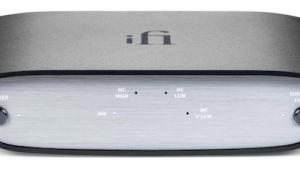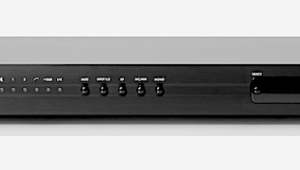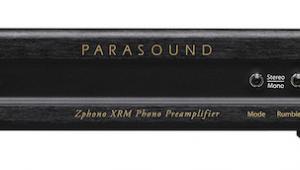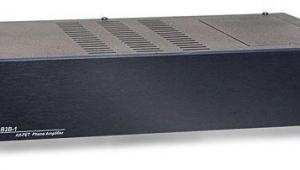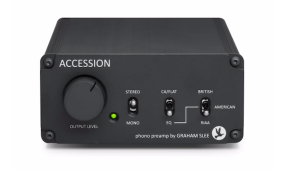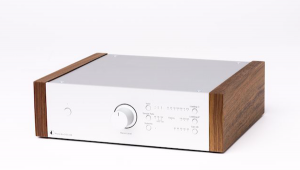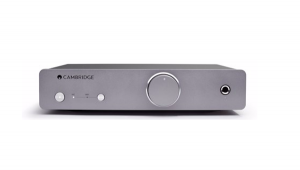Manley Labs Steelhead phono preamplifier

The Steelhead is the most flexible, user-friendly phono section I've ever encountered. There are two moving-coil (MC) inputs on the rear panel, one with RCA jacks, the other a female DIN connector. There's a single set of RCAs for the moving-magnet (MM) input. There are fixed and variable outputs, the latter associated with a front-mounted volume control and three ground lugs: one for the phono input cable, and a pair by the output jacks labeled Chassis and Circuit. Also on the back panel is one of those humongous multi-pin power-supply connectors.
The front panel's left side features a gain switch with four positions (50, 55, 60, and 65dB), which auto-mutes when you use it so that there are no speaker explosions; and a three-position input selector switch (MC1, MC2, MM). On the right side is a "big honkin' " volume control (Manley website terminology for a Noble audiophile-quality pot) and four pushbuttons, labeled Standby, Sum, Dim, and Mute. Between those, a smaller "honkin' " selector switch performs different functions, depending on whether you're using the MM or MC inputs. In MM, it allows you to select impedances of 25, 50, 100, 200 ohms, and 47k ohms. Why would you need those? Read on.
In MC mode, the switch controls a "variable-load auto tranny" (more Manley lingo), which is the Steel-head transformer/autoformer that gives the preamp its name. The switch controls five taps on the proprietary "dual-primary, bifilar wound, high-bandwidth, low-resistance, and multiple-shielded nickel-core step-up autoformer," which allows you to choose among 25, 50, 100, 200, and 400 ohm settings.
By impedance matching the cartridge with the step-up transformer, you can maximize power transfer. That means efficient, low-loss conversion of the ultra-low-voltage/high-current cartridge output to high voltage and low current. When you resistively load down an MC cartridge, you throw away power, which is why conventional loading tends to "close down" the sound as well as lowering the output—sometimes for the better, sometimes not (footnote 1). The front panel also includes switches that permit individual channel control of cartridge termination capacitance in 10pF steps up to 1100pF.
Design
The Steelhead looks like a piece of homely medical equipment from the 1950s. Call it drop-dead ugly, retro studio, or whatever—I don't think you could ever say that it looks "sleek" or "smart." Apparently, Manley is switching to a steel-colored faceplate, which should help considerably. As delivered to me, with its gaudy gold front, large ice-blue LEDs, clunky black knobs, and backlit "Manley Steelhead" TV screen-like logo, it's about as attractive as a severed fish head.
An umbilical cord terminated with a gold-plated 16-pin connector provides juice from the heavy-duty regulated outboard multichannel power supply to the main unit, each channel supplied independently (hot and ground) via multi-core shielded interconnects. The RIAA and amplifier sections each use one 6922 and two 7044 tubes in their circuits. According to the very-well-written and extremely informative instructions, the circuit "makes the best use of active and passive components and circuit developments generated over the past half-century"—which, as I found out when I asked, is an elliptical way of saying without saying that there's a JFET in the first gain stage.
When I asked Eveanna Manley whether there was a transistor in the signal path—which I suspected because of the huge amount of gain accompanied by pitch-black silence—she told me there was a large-geometry JFET in front of the first tubed gain stage. "The hybrid cascode gain blocks simultaneously deliver wide-band, high-gain, low-noise, and low-distortion performance without (large amounts of) negative feedback." The design is said to make the amplification factor of each stage insensitive to tube gain or the transconductance variations that can occur due to tube manufacturing tolerances or aging.
Mitch Margolis makes a point of comparing his design to "typical current-starved 12AX7-based preamplifier circuits," contending that the Steelhead features high quiescent and operating current in each gain stage, which lowers both static and dynamic impedances, thus raising system bandwidth.
The RIAA EQ circuit addresses all four RIAA corner frequencies or time constants (see September's "Analog Corner"), including the oft-neglected 3.2µs, which shelves to flat response at 50kHz instead of continuing to roll off HF response, as many (if not most) phono sections do. The instructions contend that allowing HF rolloff to continue causes "somewhat lifeless and remote" sound that loses impact, detail, and percussiveness. The RIAA circuit uses factory-set variable capacitors, as well as hand-selected and/or 1% tolerance resistors.
Endless Choices, Sleepless Nights
Using the Steelhead was simple, though its multiplicity of gain, loading, and other options make it a questionable choice for electrically correct, terminally obsessed audiophiles who may forever wonder whether their chosen setting is the correct or accurate one. Even the choice of MM or MC input is made more difficult—the Steelhead has sufficient gain through its MM input to accommodate a low-output MC cartridge. I'm listening right now to the new low-output (220µV) Lyra Helikon SL through the Steelhead's MM input on the 60dB gain setting, the Manley driving the Musical Fidelity Nu-Vista 300 power amp directly. The Steelhead's volume control is at 2 o'clock and it's loud! Think of that.
When you're not using it, the Steelhead can be left in Standby mode. This essentially removes all operating voltages from the unit except for system-control logic functions, which are fed by a small separate power transformer in the power supply. Push the Standby button again and the Steelhead comes to life. The Sum button combines the channels for monophonic use, but works only in the variable-output configuration—as does the Dim button, which drops output by 20dB for cueing up an LP or answering the phone. Push the Dim and Sum buttons simultaneously and small steamed morsels wrapped in delicate dough issue forth from the brightly lit Manley logo on the front panel. Fortunately, the Mute button works on both fixed and variable outputs.
Footnote 1: For a brain-spinning (well, mine spun) definition of impedance and the difference between it and resistance, click here.—Michael Fremer
- Log in or register to post comments





